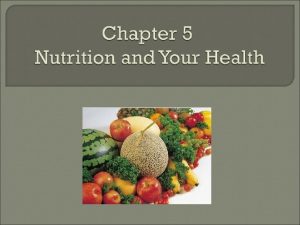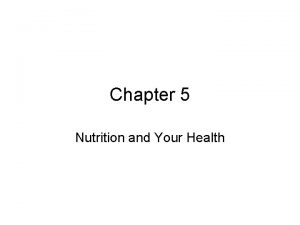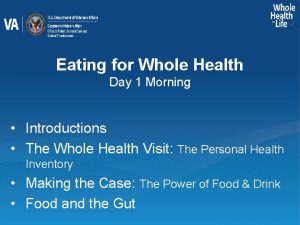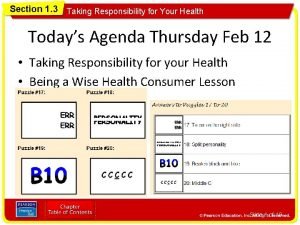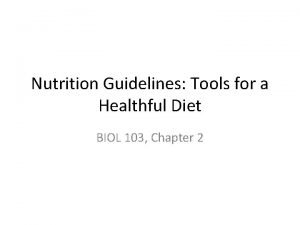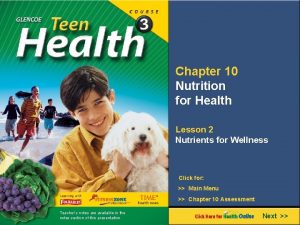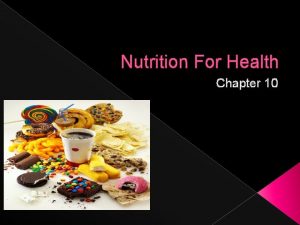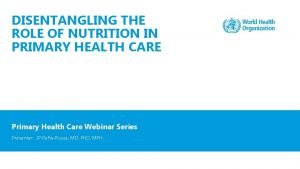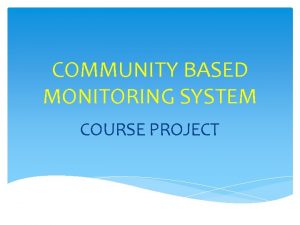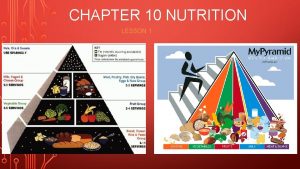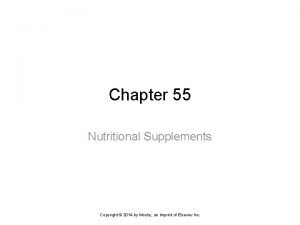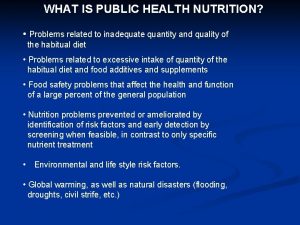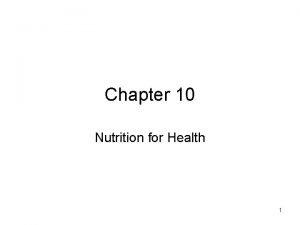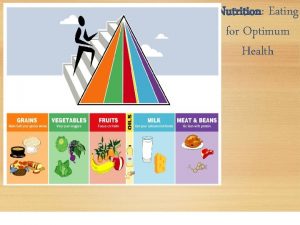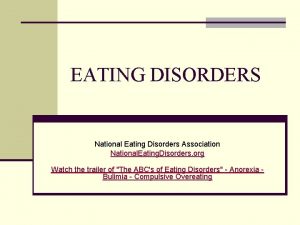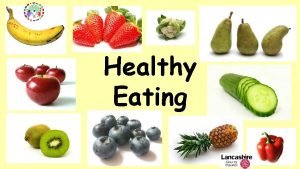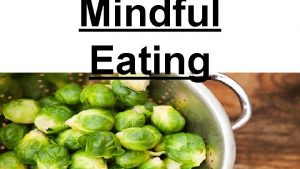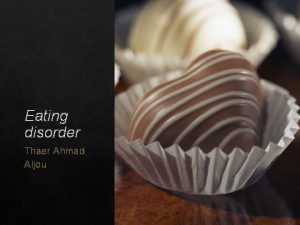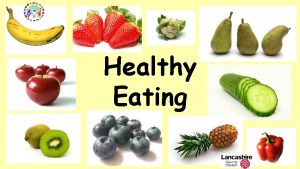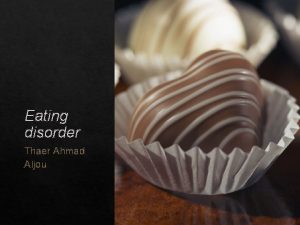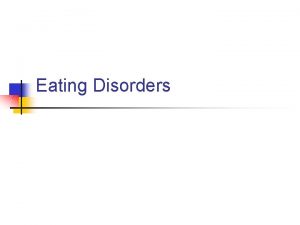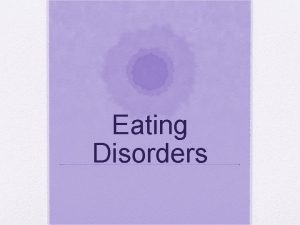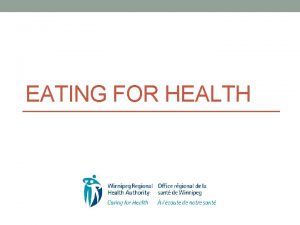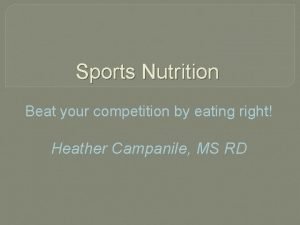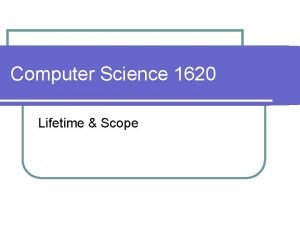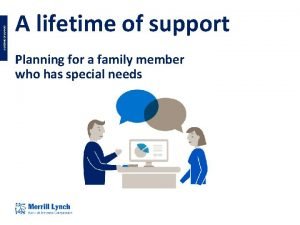NUTRITION YOUR HEALTH Eating Right for a Lifetime





















- Slides: 21

NUTRITION & YOUR HEALTH Eating Right for a Lifetime

What’s the Big Deal? • Plays a significant role in your total health • Nutrition- the process that your body takes in & uses food • Nutrients- substances your body needs to grow, repair, & supply you with energy • Calories- energy your body receives from food & uses Choosing the right foods in the right amounts will give your body the nutrients it needs for growth & development

Influences on food choices • Hunger- natural, physical drive to eat prompted by body’s need for food • Appetite- psychological desire for food (smelling fresh baked cookies) • Emotions- stressed, sad, bored, reward, “mindless eating” • Family- what they buy, make, culture • Friends • Time & money- quick, convenient, cheap • Advertising- make it appealing

You are what you eat! Nutrients • 3 types that provide energy: • Carbohydrates: starches & sugars that are the main source of energy 1. Simple- sugars: fructose & lactose 2. Complex- starches: grains, potatoes 3. Fiber- complex- not digested- breaks down & stored for later use Boys- 38 grams of total carbs= fiber Girls- 26 grams of total carbs= fiber Carbs- 45 -65% of calories

You are what you eat! Nutrients • Proteins- used to help you grow, build & maintain cells, muscles, & tissues Found in meats, eggs, dairy Boys- 52 grams Girls- 46 grams • Fats- concentrated form of energy, brain development, reduce inflammation 1. Unsaturated- oils, nuts, seeds (good) 2. Saturated- animal-based (not so good) 3. Trans- margarine, snacks, packaged cookies (bad) 25 -35% of calories from fat = 55 -75 g Girls 70 -100 g Boys Calories not used stored as fat & can provide insulation

You are what you eat! Nutrients • 3 types that perform a variety of body functions: • Vitamins- regulate body processes 1. Water-soluble-not stored- help process carbs, proteins, & fats, help immune system B, C, Folic Acid 2. Fat-soluble- stored for later use- cell growth & repair A, D, E, K • Minerals- must get from food Calcium & phosphorus- bones & teeth Iron- carries oxygen helps immune system • Water- essential for most body functions 9 -13 cups (8 oz) a day- more if you are active

Healthy Eating Guidelines • Dietary Guidelines- recommendations created by the USDA- information on the importance of healthful eating & active living 3 Keys: 1. Making smart choices- variety of foods check out www. My. Pyramid. gov * Focus on fruits * Lean protein * Vary veggies * Half of grains- whole * Calcium-rich foods * Limit fats, sugar, salt

Guidelines 2. Balance Food & Activity * 60 minutes exercise a day 3. Nutrient-dense foods * High ratio nutrients to calories * Get the most nutrition for your calories * Calories depend on age, gender, activity

Healthy Eating Patterns • Use My. Pyramid to plan meals & snacks- adapts to any eating style: 3 bigger meals vs. 6 smaller meals plate diagram • EAT BREAKFAST!!!!! • SNACKS - Fruits, vegetables, string cheese, nuts, popcorn, yogurt, pretzels • Dining out: - Portion sizes, preparation, toppings, drinks

• Naturally occurring -fruits & milk • Added- during processing or preparationfruit drinks, soft drinks, cookies, candy, cakes, cereals- includes white or brown sugar, honey, high fructose corn syrup • 1 teaspoon = 4 grams of sugar • 4 calories per gram of sugar • http: //www. webmd. com/foodrecipes/features/sugar-shockers-foods-

High Fructose Corn Syrup Dangers: • Average person consumes 60 lbs per year • More rapidly absorbed – affects the liver (fatty liver)- triggers insulin spikes causing increased appetite & weight gain • In high doses can put holes in intestinal lining causing bacteria & food particles to move to bloodstream • Contains contaminants not regulated by FDA • Found in nutrient-poor processed food




Maintaining a Healthy Weight • Calorie Connection: * It’s all about balance- what you take in vs. what you burn = energy balance * Consume more than you lose- gain weight * Use more than you take in- lose weight * Burn what you take in- maintain weight * 3500 calories = 1 lb fat * Metabolism- process where the body converts food to fuel- varies person to person


Maintaining a Healthy Weight • High fat foods are high calorie foods! * 1 gram of fat = 9 calories * 1 gram of protein/carbs = 4 calories • Depends on food preparation as well: * fried vs grilled/baked, cream sauces, oils • BMI- Body Mass Index- body weight relative to height 16 -23% is healthy • Body Composition- ratio of fat to lean body tissue - Males- 11 -25% average Females- 16 -25% average

Eating Disorders • Extreme eating behaviors that can cause serious illness or death- 3 types • Classified as mental illnesses 1. Anorexia- irrational fear of weight gain leading to self-starvation * see themselves as overweight * comes from outside pressure * need for acceptance/ need to achieve * perfectionist

Eating Disorders- Anorexia SIGNS * Avoid eating or few foods in small amounts * Obsessive counting calories * Excessive exercise * Constantly weighing self • SYMPTOMS *Brittle bones * Lower heart rate & blood pressure * Heart problems * Low energy/weak

Eating Disorders 2. Bulimia- cycles of over-eating & purging- eat huge amounts of food at once then forcing vomit or laxatives - typically in normal weight range but fear of weight gain SYMPTOMS: * dehydration * sore/inflamed throat * damage to teeth, stomach, esophogus * irregular heart beat, heart failure

Eating Disorders 3. Binge Eating- compulsive over-eatingconsume large amounts- may feel guilty but powerless to stop * 1/3 of all cases are male * overweight/obese * high blood pressure * Type 2 Diabetes * Heart Disease
 Right product right place right time right price
Right product right place right time right price Right time right place right quantity right quality
Right time right place right quantity right quality Put your right foot in put your right foot out
Put your right foot in put your right foot out The right man on the right place at the right time
The right man on the right place at the right time A natural physical drive that prevents starvation
A natural physical drive that prevents starvation A saturated fatty acid holds all the hydrogen atoms it can.
A saturated fatty acid holds all the hydrogen atoms it can. Stairway to lifetime fitness health and wellness
Stairway to lifetime fitness health and wellness Lifetime fitness augusta health
Lifetime fitness augusta health Stairway to lifetime fitness health and wellness
Stairway to lifetime fitness health and wellness How eating healthy affects your body
How eating healthy affects your body Your health your responsibility
Your health your responsibility Socio-ecological model of nutrition & health
Socio-ecological model of nutrition & health Chapter 10 lesson 2 nutrients
Chapter 10 lesson 2 nutrients Chapter 10 nutrition for health vocabulary practice
Chapter 10 nutrition for health vocabulary practice Nutrition in primary health care
Nutrition in primary health care Project title for health and nutrition
Project title for health and nutrition Chapter 10 nutrition for health lesson 1 answer key
Chapter 10 nutrition for health lesson 1 answer key Positive food
Positive food Chapter 55 nutrition and health
Chapter 55 nutrition and health Public health nutrition problems
Public health nutrition problems Introduction to public health nutrition
Introduction to public health nutrition Chapter 10 nutrition for health
Chapter 10 nutrition for health




